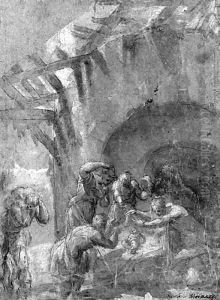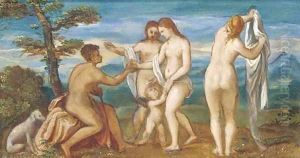Andrea Meldolla, Il Schiavone Paintings
Andrea Meldolla, also known as Il Schiavone (which means 'the Slavonian'), was an Italian Renaissance painter hailing from what is now Croatia, which was then part of the Venetian Republic. He was born around 1510 to 1515 in the town of Zara (now Zadar, Croatia). His nickname reflects his Dalmatian heritage, as 'Schiavone' was used in Venetian to denote someone from the Slavic regions of the Venetian Republic.
Meldolla trained in Venice, which was a major artistic center during the Renaissance, and his work was significantly influenced by the Venetian School, particularly by the style of Titian and the innovations of Parmigianino and the Mannerists. He was known for his distinctive use of color and loose, energetic brushwork, which set him apart from his contemporaries. His paintings often display a dynamic composition, vigorous execution, and a preference for dramatic lighting effects.
Despite his evident talent, Il Schiavone never achieved the same level of fame as some of his Venetian contemporaries. However, he was appreciated by knowledgeable patrons and his works were sought after in his time. His oeuvre includes a range of religious subjects, mythological scenes, and portraits. Some of his notable works are 'The Adoration of the Shepherds', 'The Killing of Abel', and 'The Marriage of Cupid and Psyche'.
Meldolla's career was marked by a consistent output of altarpieces and frescoes for Venetian churches and other institutions, but few of these survive to the present day. His style had an influence on later Venetian painters, including the young Jacopo Tintoretto. Il Schiavone's work was also collected by connoisseurs in the centuries following his death, and his influence can be seen in the works of artists outside of Italy, such as the Spanish Baroque painter Jusepe de Ribera.
Andrea Meldolla died in Venice in 1563. While not as well-remembered as some of his peers, recent scholarship and exhibitions have started to bring more attention to his contributions to the Renaissance art of the Venetian School. His work can be found in various museums and collections around the world, where his distinctive style continues to be appreciated by art lovers and scholars alike.

